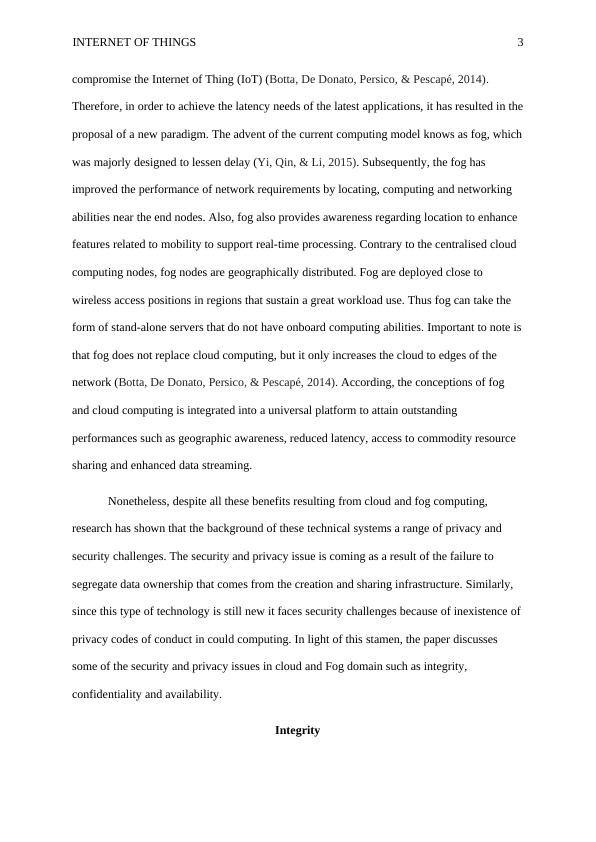Internet of Things: Security and Privacy Issues in Cloud and Fog Domain
Added on 2021-06-17
8 Pages1892 Words23 Views
Running head: INTERNET OF THINGS 1Internet of Things: Security and Privacy Issues in Cloud and Fog DomainStudent’s Name Institution Affiliation

INTERNET OF THINGS 2IntroductionThe emergence of cloud computing has become a mainstream model for realising the requirements of computing among enterprises and individual users. The cloud environment ispremised on the perspective of resource sharing. The converging infrastructure of the internethas made it possible and heightened the dependability, real-time resource provisioning and economies of scale. The emergence of cloud computing has given an elastic computing platform such that it can provide on-demand services which scale to attain peel loads. Accordingly, the deployment of software in the cloud setting has also intensified agility as the procedure for re-providing infrastructural technology that is expansively simplified. Furthermore, clouds offer location independence as it is accessible to any client who has a web browser. Clouds are constructed on a range of layers of both software and hardware, which in most cases consists of commodity servers, guest operating systems, hypervisors and guest applications (Botta, De Donato, Persico, & Pescapé, 2014). Traditionally, clouds are housed in big data centres which are located near fibre networks. Also, another reason for hosting clouds in huge data centres is because they are giant consumers of energy. Thus they have to be developed in places that have access to cheap power supply. While centralised computing consists of a myriad of advantages, it is saddled with some challenges. The core challenge is a delay which means that there is the lag between customer request and cloud response. Subsequently, this is described by the fact that data centres are normally positioned well far from major metropolitans as well as densely populated regions. Another limitation that comes is the physical distance in between the end users and data centres which results in an effect on latency. Certainly, this effect is problematic for systems that depend greatly upon streaming data as well as offline processingand storage. An example of this type of systems includes mobile devices, sensor network, autonomous systems, as well as clients with thin-layer OS. Altogether, these equipment

INTERNET OF THINGS 3compromise the Internet of Thing (IoT) (Botta, De Donato, Persico, & Pescapé, 2014). Therefore, in order to achieve the latency needs of the latest applications, it has resulted in theproposal of a new paradigm. The advent of the current computing model knows as fog, whichwas majorly designed to lessen delay (Yi, Qin, & Li, 2015). Subsequently, the fog has improved the performance of network requirements by locating, computing and networking abilities near the end nodes. Also, fog also provides awareness regarding location to enhance features related to mobility to support real-time processing. Contrary to the centralised cloud computing nodes, fog nodes are geographically distributed. Fog are deployed close to wireless access positions in regions that sustain a great workload use. Thus fog can take the form of stand-alone servers that do not have onboard computing abilities. Important to note isthat fog does not replace cloud computing, but it only increases the cloud to edges of the network (Botta, De Donato, Persico, & Pescapé, 2014). According, the conceptions of fog and cloud computing is integrated into a universal platform to attain outstanding performances such as geographic awareness, reduced latency, access to commodity resource sharing and enhanced data streaming. Nonetheless, despite all these benefits resulting from cloud and fog computing, research has shown that the background of these technical systems a range of privacy and security challenges. The security and privacy issue is coming as a result of the failure to segregate data ownership that comes from the creation and sharing infrastructure. Similarly, since this type of technology is still new it faces security challenges because of inexistence ofprivacy codes of conduct in could computing. In light of this stamen, the paper discusses some of the security and privacy issues in cloud and Fog domain such as integrity, confidentiality and availability. Integrity

End of preview
Want to access all the pages? Upload your documents or become a member.
Related Documents
Integration of Cloud Computing and Internet of Things: A Surveylg...
|7
|1763
|36
Cloud Computing: Advantages, Disadvantages, and Implementationlg...
|8
|342
|321
Concept of Cloud Computing - PDFlg...
|9
|567
|319
Infrastructure of Cloud Computing: Methodology and Trusted Computinglg...
|10
|648
|46
Cloud Computing Technology and Application: A Comparison of Major Vendors-Proposallg...
|11
|559
|144
Annotated Bibliography on Emerging Technology and Innovationslg...
|14
|3320
|425